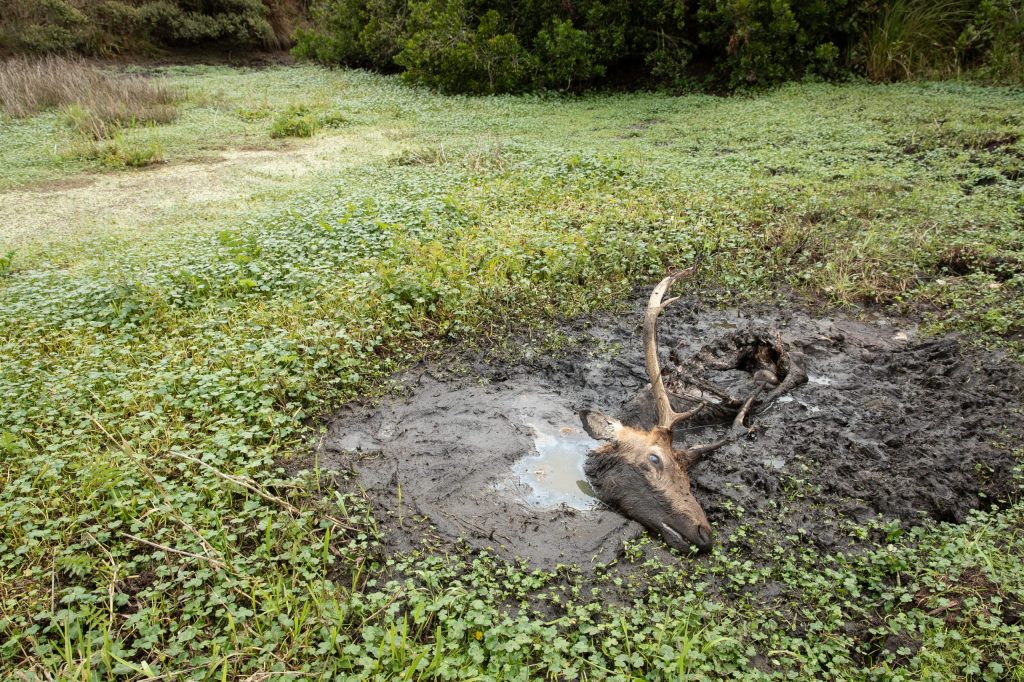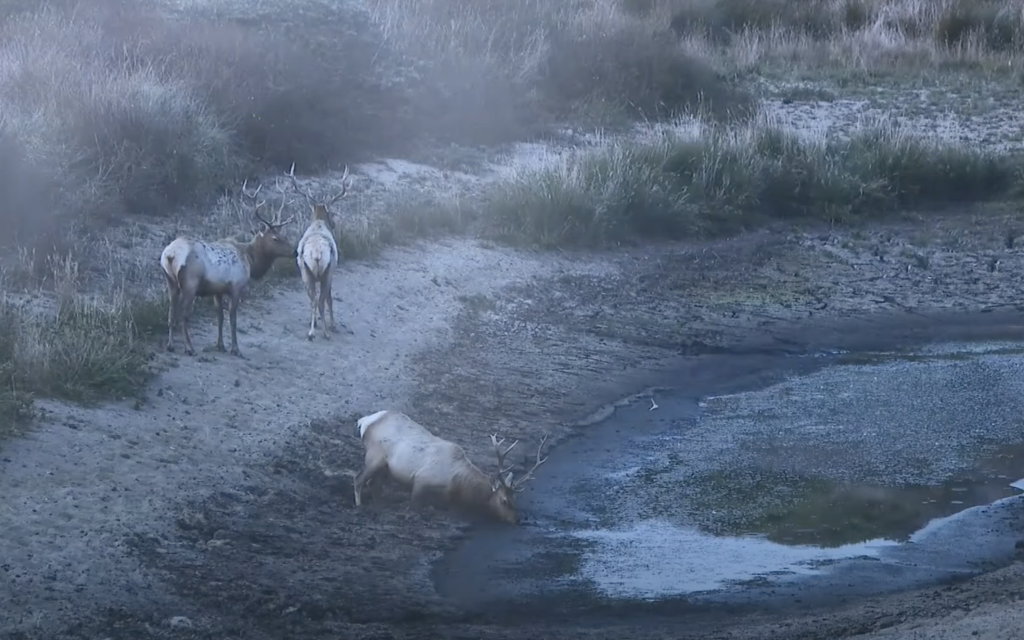NFL/NBA Celeb Bonnie-Jill Laflin Dunks on Cattle Ranchers at Protest to Save Point Reyes Tule Elk
(EnviroNews California) — San Francisco, California — Bonnie-Jill Laflin has six championship sports rings — spanning two men’s sports: five NBA rings and one NFL Super Bowl ring. She earned those as a cheerleader with the San Francisco 49ers in the NFL, and as an executive in the NBA with the LA Lakers. Not even Tom Brady nor Lebron James can flaunt such a variety of rings. She’s a lady of firsts, and as TreeSpirit Project Founder Jack Gescheidt pointed out when introducing her at an animal rights protest in San Francisco, “She’s the first and only female NBA scout, also first to hold a front-office position with the LA Lakers, first to dance on a professional level for three teams in two sports with the NBA with the Golden State Warriors, and then the NFL with both the 49ers and the Dallas Cowboys.” But this was definitely not the first time Laflin has come to the defense of animals in peril — not by a long shot.
Laflin, who has advocated for animals around the world, threw down to a crowd of protestors at Crissy Field in San Francisco, California, on December 4, 2021 at an event sponsored by In Defense of Animals (IDA), Western Watersheds Project (WWP), TreeSpirit Project and Turtle Island Restoration Network. The uproar is over the National Park Service’s (NPS) recent Record of Decision (RoD) to adopt an amendment to the 1998 Tule Elk General Management Plan (GMP) for the Point Reyes National Seashore (PRNS/the Seashore/the park) in Marin County, California. The amendment, titled Alternative B, is loathed by the environmental movement because it gives 24 cattle ranches a pass to continue operating in the park for the next 20 years. It also enables the Park Service to shoot and kill native tule elk (Cervus canadensis nannodes) in the Drakes Beach Herd — the only truly wild herd at the Seashore. This is to stop the herd from growing beyond its current numbers of approximately 140 specimens.
“And then learning that this was all because cattle ranchers are using the public lands to raise over 5,000 cows, and to compete with just the 600 elk for land and food and water,” Laflin said to the determined crowd. “And now, the National Park Service supports a plan to shoot some of the tule elk at the request of the ranchers.”
Tule elk are the smallest species of North American elk and are endemic to California. After European pioneers hunted them to near extinction, a dozen or less animals remained. Today, the species’ hovers at approximately 5,000 animals in the wild. Historic tule elk numbers were said to have topped 500,000. Animal advocates and conservation groups have been demanding the Park Service evict the ranchers and remove all of their infrastructure and fencing. They also insist an eight-foot-high elk fence be taken out as well — a fence that currently separates the larger NPS-managed Tomales Point Herd from the wild Drakes Beach and Limantour herds.
A controversy ensued when Point Reyes NPS released a report back in March that showed 152 animals in the Tomales Point Herd had perished. According to the NPS website “poor forage quality is the underlying cause of these population changes.” Point Reyes NPS also claimed “there is no evidence that the population decline is due to dehydration and a lack of water.” But many of the “elktivists” present at the San Francisco event strongly disagree with that assessment and say the Point Reyes NPS unit is derelict in its duty; they say the Tomales Point elk are thirsting to death and are unable to roam beyond the fence for better forage and water.

After advocacy filmmakers and photographers captured elk that had become trapped and died in dried-up water holes, they tried to come to the rescue of the elk, putting out drinking troughs for the herd confined behind the elk fence. Jack Gescheidt spearheaded that effort, and instead of being commended by the National Park Service for providing relief for a herd of animals dying under the agency’s management, he told EnviroNews he was issued a citation for “disorderly conduct creating a hazardous situation” instead. The next day NPS dumped and removed the troughs. But only a few months later, Point Reyes NPS put their own water troughs out for the Tomales Point herd, after taking heat over the report showing the amount of elk fatalities.

“I’ve been following the story of Point Reyes for some time now, and I was heartbroken to see, especially when I found out that they were depriving them of water and food, and just dying of miserable deaths, and the lack of food and nutrients, I just had to get more involved,” Laflin asserted.
Sources tell EnviroNews lawsuits are being prepared over NPS’ RoD for the Tule Elk GMP, including one by Resource Renewal Institute (RRI), alongside heavy-hitting environmental organizations Western Watersheds Project and the Center for Biological Diversity — groups that frequently sue the federal government over deficient environmental impact statements (EIS) for wildlife management plans. Both those NGOs boast a success rate over 90% when suing the federal government in court on wildlife cases.
The full transcript to Laflin’s speech at the San Francisco event reads as follows:
Bonnie-Jill Laflin: Thank you all. First, I want to thank all of you for being here today. It’s a big deal to have anyone in the presence of the tule elk, and being here in this beautiful atmosphere, and for the guy over here [who was harassing the elktivists], that means we’re doing something right. Right? I think if someone is that upset, it means we are doing something.
I want to start off with that, I grew up with the tule elk, and when I say that — I don’t know if you guys are familiar with the Concord area — but our backyard would back right into Port Chicago. And there was the tule elk. So, every day I would go out there, and as a little girl [I was] just fascinated with them on their beauty. And now, as an animal advocate, I’ve been following the story of Point Reyes for some time now, and I was heartbroken to see, especially when I found out that they were depriving them of water and food, and just dying of miserable deaths, and the lack of food and nutrients, I just had to get more involved, and so that’s why I contacted IDA after they said, “Hey, can you get more involved?”
And then learning that this was all because cattle ranchers are using the public lands to raise over 5,000 cows, and to compete with just the 600 elk for land and food and water. And now, the National Park Service supports a plan to shoot some of the tule elk at the request of the ranchers. And I was outraged, because if the animals can’t be saved in a national park, where can they be safe? (applause)
The tule elk are rare animals who deserve protection and not a bullet from the cattle ranchers. For me, and for many of us here, they’re a national attraction. And I’ll tell you, I’ve seen this, and been in some of these factory farms, and they definitely are not. The question is now, is the Park Service putting animals and the environment before the ranchers? And that’s my problem, because it’s all for profit. It’s not the purpose of the national parks, as most of us know. (applause)
Some facts about Point Reyes: factory farms have contaminated the waterways and destroyed coastal wildlife habitat. Also, cows can be confined and abused and tortured, so at the end of the day, we’re abusing two different animals, and that’s a big, big, big problem. The situation is not right for the animals affected, and I feel like [it’s] an injustice and it needs to be rectified, and so many species of animals are destroyed because of the animal ag industry.
So, I’m vegan, but you don’t have to be vegan or vegetarian to care about this, and what’s happening at the National Seashore, because it’s wrong on so many levels. These magnificent animals have grazed the peninsula for 10,000 years — 10,000 years. So, we need our voice to save them, and the lives of the tule elk depend on it. So, thank you.
FILM AND ARTICLE CREDITS
- Emerson Urry - Journalist, Author, Producer, Video Editor, Colorist, Sound Editor, 3D Animator
- Dakota Otero - A Camera Operator, B Camera Operator, Assistant Editor




